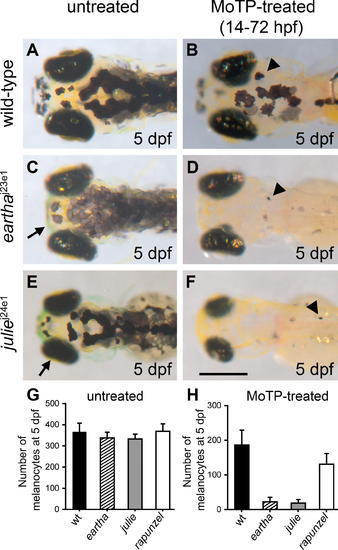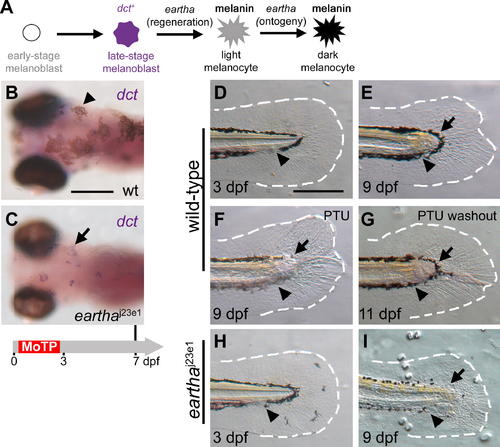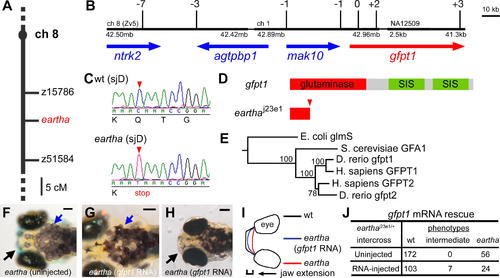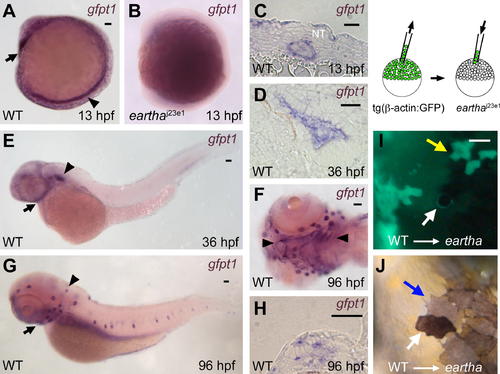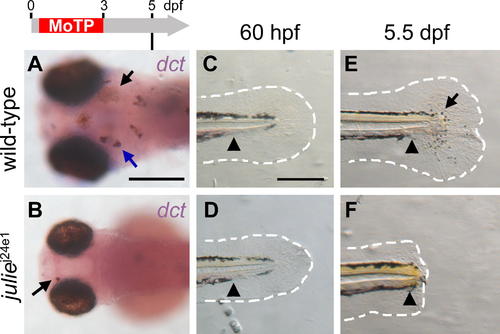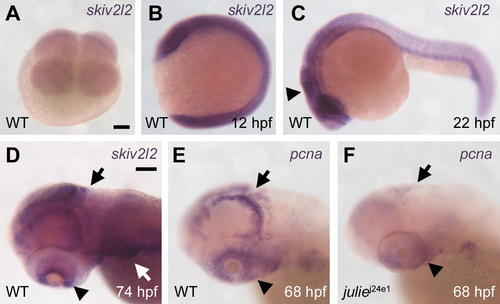- Title
-
Mutations in gfpt1 and skiv2l2 Cause Distinct Stage-Specific Defects in Larval Melanocyte Regeneration in Zebrafish
- Authors
- Yang, C.T., Hindes, A.E., Hultman, K.A., and Johnson, S.L.
- Source
- Full text @ PLoS Genet.
|
Mutations Specific to Melanocyte Regeneration (A–F) earthaj23e1 (C) and juliej24e1 mutants (E) both develop larval melanocyte patterns nearly identical to wild-type larvae (A), although melanocytes in earthaj23e1 mutants appear to have lighter pigmentation than that in the wild-type larvae. Upon larval melanocyte ablation by MoTP (14–72 hpf), wild-type larvae (B) regenerate many melanocytes at 5 dpf (arrowhead in [B]), while earthaj23e1 (arrowhead in [D]) and juliej24e1 (arrowhead in [F]) mutants largely fail to regenerate melanocytes. Additional phenotypes are indicated by an arrow in (C) marking a shortened pharyngeal skeleton in earthaj23e1 mutants and by an arrow in (E) indicating small eyes and head in juliej24e1 mutants. (G–H) The numbers of melanocytes in the untreated (G) and MoTP-treated (H) wild-type and mutant larvae at 5 dpf. Scale bar: 300 μm. PHENOTYPE:
|
|
The earthaj23e1 Mutation Specifically Affects Melanocyte Regeneration after the dct+ Stage but Has No Effect on Larval Tail Regeneration (A) The roles of eartha in different stages of melanocyte development in ontogeny and regeneration are presented. (B and C) Larval melanocytes in the wild-type (B) and earthaj23e1 (C) larvae were ablated by MoTP treatment from 14 to 72 hpf, and melanocyte regeneration was analyzed at 7 dpf by ISH with dct riboprobes for late-stage melanoblasts. At this stage, many melanocytes (melanin+) have regenerated in the wild-type larvae (arrowhead in [B]). Although only few pigmented melanocytes appear in earthaj23e1 larvae at the same stage, many dct+ melanoblasts (melanin-, stained purple) are revealed by ISH (arrow in [C]). (D–I) earthaj23e1 mutation specifically affects melanocyte regeneration during larval tail regeneration. Arrowheads show amputation planes at 3 dpf prior to amputation (D) and (H) and after regeneration (E–G) and (I). Wild-type larval tails (D) were amputated at 3 dpf. The wound healed in the ensuing two days by closing the injured tip of the notochord and neural tube, followed by the outgrowth of fin fold. By 9 dpf (6 d postamputation), the missing larval tails were reconstituted, including fin-fold tissues (outlined with white-dashed lines) and melanocytes (arrow in [E]). The origins of the re-established tail melanocytes were investigated by incubating larvae in PTU immediately after larval tail amputations (F). PTU prevents melanin synthesis in newly differentiated melanocytes, and thus the pigmented melanocytes that appear in regenerated tails of the PTU-treated larvae pre-existed prior to the tail amputation. At 9 dpf, few melanocytes (arrow in [F]) appear in the newly regenerated tail immediately distal to the amputation plane in the PTU-treated larvae, suggesting that these melanocytes arise from the migration of proximately differentiated melanocytes from the stump (F). Additional lightly pigmented melanocytes appear after PTU washout (arrow in [G]), indicating that these melanocytes are newly differentiated. When similar tail amputations were conducted in earthaj23e1 larvae (H and I), the larval tails regenerated identically to wild-type larvae, except that few melanocytes appear in the regenerated tail in the region immediately distal to the amputation plane (arrow in [I]). The white-dashed lines outline the fin folds. Timeline (grey) below (C) indicates the period of MoTP treatment (red) and analysis time (vertical line above the timeline). Scale bars: 250 μm. |
|
The earthaj23e1 Mutation Affects Cartilage Maturation (A–F) The pharyngeal skeleton of wild-type and earthaj23e1 larvae are revealed by Alcian Blue staining, where the staining in earthaj23e1 larvae (B) is significantly weaker than that in wild-type larvae (A). At 10 dpf, the chondrocytes in the symplectic (SY) region (arrowhead in [C] and [E]) of the hyosymplectic cartilage are arranged into a single cell wide stack (arrowhead in [E]) in wild-type larvae. This organization of chondrocytes is disarranged in the earthaj23e1 larvae (arrowheads in [D] and [F]). Arrows in (A) and (B) indicate the hyosymplectic cartilages that are shown in (C) and (D). Arrowheads in (C) and (D) mark the SY region of hyosymplectic cartilage. (E) and (F) are enlarged images of the SY region of hyosymplectic cartilage. Scale bars: 100 μm. |
|
The earthaj23e1 Mutation Is a Nonsense Mutation in gfpt1 (A–E) The earthaj23e1 mutation was mapped to Chromosome 8 between z15786 and z51584 (A). The physical map of the eartha locus was built from the zebrafish genome assembly version 5 (Zv5) with the support of recombination observed in 1,514 meioses. Shown here is a portion of this physical map delimited by seven recombinants at the proximal end and three recombinants at the distal end, containing approximately 189 kb comprising four genes: ntrk2, agtpbp1, mak10, and gfpt1 (B). Sequencing of the earthaj23e1 cDNA for gfpt1 revealed a nonsense mutation in the third exon, where a CAA to TAA substitution resulting in Gln to stop cordon change (C) and (D). The phylogenetic tree of gfpt genes was constructed by using the neighbor-joining method with E. coli glmS as the out-group (E). (F–J) gfpt1 mRNAs partially rescue the eartha phenotypes. gfpt1 mRNAs were in vitro synthesized and injected into one to four cell stage embryos. At 5–7 dpf, 22% of the earthaj23e1 larvae injected with gfpt1 mRNA (J) have some distinctly darker melanocytes (blue arrows in [G]) and more extended pharyngeal skeletons (black arrow in [H] and [I]) than those in the noninjected earthaj23e1 larvae (black and blue arrows in [F]). SIS: sugar isomerase domain. Scale bars: 100 μm. |
|
gfpt1 Is Expressed in Notochord, Ear, and Pharyngeal Arches, and Acts Cell Autonomously in Melanocytes to Promote Melanocyte Darkening (A–H) ISH reveals high expression of gfpt1 in the notochord (arrowhead in [A]) and the pillow (polster, arrow in [A]) at 13 hpf. No or very few gfpt1 transcripts were detected in the earthaj23e1 mutants at 13 hpf (B). A cross section (C) shows the gfpt1 expression in notochord at 13 hpf. gfpt1 is expressed in the ear (arrowhead in [E]) and pharyngeal arches (arrow in [E]) at 36 hpf. gfpt1 expression in the sensory epithelium of the ear is shown in a cross section (D). At 96 hpf, gfpt1 is expressed in the lateral line neuromasts (arrowhead in [G]) and the pharyngeal arches (arrow in [G] and arrowheads in [F]). A cross section (H) shows the gfpt1 expression in the neuromasts. (I–J) Chimeric animals were generated by transplanting wild-type tg(β-actin:GPF) donor cells into earthaj23e1 embryos at midblastula stage. A donor (GFP+) melanocyte in the eartha larvae is revealed following incubation in 0.1% epinephrine to induce melanosome contraction (white arrow in [I]). In the uncontracted state, the GFP+ (donor-derived) melanocyte appears darkly pigmented, in contrast to the lightly pigmented neighboring melanocytes (GFP-) that are derived from host (blue arrow in [J]). Yellow arrow in (I) indicates donor-derived skin cells (GFP+) that are not associated with darkened melanocytes. Scale bars: in (A), 50 μm for (A and B); in (C and D) and (H), 20 μm; in (E–G), 50 μm; in (I), 50 μm for (I and J). EXPRESSION / LABELING:
|
|
juliej24e1 Mutation Disrupts Melanocyte Regeneration prior to the dct+ Stage and Blocks Tail Regeneration Following Amputation (A and B) Larval melanocytes in juliej24e1 and wild-type larvae were ablated by MoTP treatment from 14 to 72 hpf, and melanocyte regeneration was analyzed at 5 dpf by ISH with dct riboprobes for late-stage melanoblasts. At this stage, many dct+ melanoblasts (melanin-, blue arrow in [A]) and melanocytes (melanin+, black arrow in [A]) appear in wild-type larvae (A). While few melanocytes (melanin+, black arrow in [B]) appear in the juliej24e1 larvae, no dct+ melanoblast was detected by ISH (B). (C–F) juliej24e1 mutants fail to regenerate larval tails following amputation. Larval tails were amputated at 60 hpf (C and D) and tail regeneration in wild-type and juliej24e1 larvae were examined at 5.5 dpf (E and F). At this stage, wild-type larval tails (E) were mostly reconstituted, including fin-fold tissues (outlined with white-dashed line) and melanocytes (arrow in [E]). In the juliej24e1 larvae, the amputation wound healed but the juliej24e1 mutant tail failed to regenerate (F). Arrowheads indicate the amputation planes in (C–F). The white-dashed lines outline the fin folds. Timeline (grey) above (A) indicates the period of MoTP treatment (red) and analysis time (vertical line below the timeline). Scale bars: 250 μm. |
|
skiv2l2 Expression Is Ubiquitous during Embryogenesis and Then Restricted to Proliferation Zones at Larval Stages (A and B) skiv2l2 transcripts were detected as early as the four-cell stage by RNA ISH (A) and remained ubiquitously distributed in embryos throughout early embryogenesis (B) (12 hpf). (C and D) The expression of skiv2l2 becomes stronger in the central nervous system (arrowhead in [C]) (22 hpf) and is then restricted to pectoral fins, cranial neural crest (white arrow in [D]), the medial and posterior parts of the tectum, and cerebellum (black arrow in [D]), and ciliary marginal zone of the retina (arrowhead in [D]) at larval stages (D) (74 hpf). (E) This larval-stage expression pattern of skiv2l2 is nearly identical to the expression of pcna (68 hpf). (F) pcna expression is drastically reduced in juliej24e1 mutants (68 hpf). Scale bars: in (A), 100 μm for (A–C); in (D), 100 μm for (D–F). |

Unillustrated author statements EXPRESSION / LABELING:
PHENOTYPE:
|

